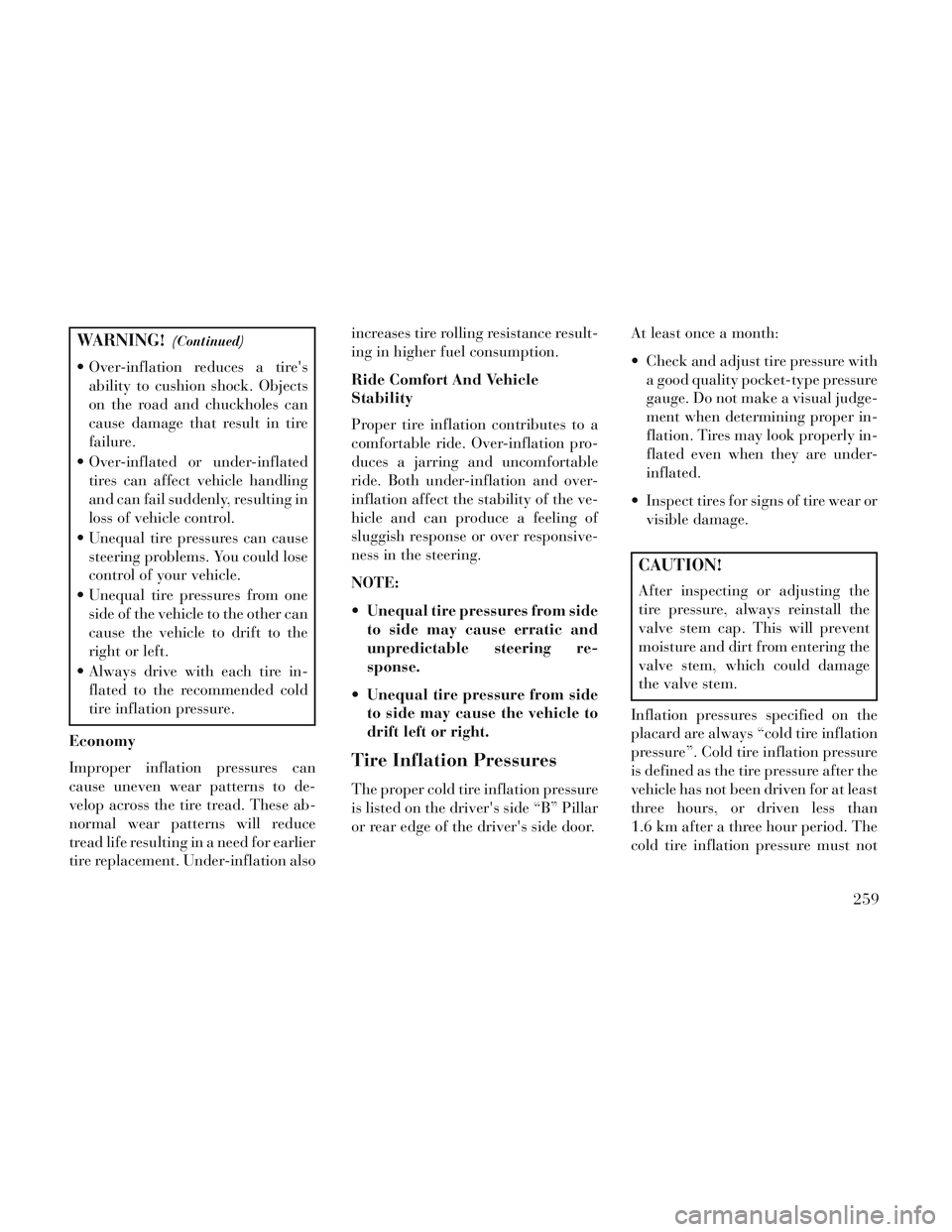lug pattern Lancia Voyager 2014 Owner handbook (in English)
[x] Cancel search | Manufacturer: LANCIA, Model Year: 2014, Model line: Voyager, Model: Lancia Voyager 2014Pages: 364, PDF Size: 3.49 MB
Page 265 of 364

WARNING!(Continued)
Over-inflation reduces a tire'sability to cushion shock. Objects
on the road and chuckholes can
cause damage that result in tire
failure.
Over-inflated or under-inflated tires can affect vehicle handling
and can fail suddenly, resulting in
loss of vehicle control.
Unequal tire pressures can cause steering problems. You could lose
control of your vehicle.
Unequal tire pressures from one side of the vehicle to the other can
cause the vehicle to drift to the
right or left.
Always drive with each tire in- flated to the recommended cold
tire inflation pressure.
Economy
Improper inflation pressures can
cause uneven wear patterns to de-
velop across the tire tread. These ab-
normal wear patterns will reduce
tread life resulting in a need for earlier
tire replacement. Under-inflation also increases tire rolling resistance result-
ing in higher fuel consumption.
Ride Comfort And Vehicle
Stability
Proper tire inflation contributes to a
comfortable ride. Over-inflation pro-
duces a jarring and uncomfortable
ride. Both under-inflation and over-
inflation affect the stability of the ve-
hicle and can produce a feeling of
sluggish response or over responsive-
ness in the steering.
NOTE:
Unequal tire pressures from side
to side may cause erratic and
unpredictable steering re-
sponse.
Unequal tire pressure from side to side may cause the vehicle to
drift left or right.
Tire Inflation Pressures
The proper cold tire inflation pressure
is listed on the driver's side “B” Pillar
or rear edge of the driver's side door. At least once a month:
Check and adjust tire pressure with
a good quality pocket-type pressure
gauge. Do not make a visual judge-
ment when determining proper in-
flation. Tires may look properly in-
flated even when they are under-
inflated.
Inspect tires for signs of tire wear or visible damage.
CAUTION!
After inspecting or adjusting the
tire pressure, always reinstall the
valve stem cap. This will prevent
moisture and dirt from entering the
valve stem, which could damage
the valve stem.
Inflation pressures specified on the
placard are always “cold tire inflation
pressure”. Cold tire inflation pressure
is defined as the tire pressure after the
vehicle has not been driven for at least
three hours, or driven less than
1.6 km after a three hour period. The
cold tire inflation pressure must not
259
Page 293 of 364

WHEEL AND TIRE
TORQUE
SPECIFICATIONS
Proper lug nut/bolt torque is very im-
portant to ensure that the wheel is
properly mounted to the vehicle. Any
time a wheel has been removed and
reinstalled on the vehicle the lug nuts/
bolts should be torqued using a prop-
erly calibrated torque wrench.
TORQUE SPECIFICATIONS
Lug Nut/Bolt
Torque **Lug
Nut/Bolt
Size Lug
Nut/Bolt Socket Size
135 N·m M12 x
1.25 19 mm
**Use only LANCIA recommended
lug nuts/bolts and clean or remove
any dirt or oil before tightening.
Inspect the wheel mounting surface
prior to mounting the tire and remove
any corrosion or loose particles. Tighten the lug nuts/bolts in a star
pattern until each nut/bolt has been
tightened twice.
After 40 km check the lug nut/bolt
torque to be sure that all the lug nuts/
bolts are properly seated against the
wheel.
WARNING!
To avoid the risk of forcing the ve-
hicle off the jack, do not tighten the
lug nuts fully until the vehicle has
been lowered. Failure to follow this
warning may result in personal in-
jury.
JACKING AND TIRE
CHANGING
WARNING!
Do not attempt to change a tire on
the side of the vehicle close to
moving traffic. Pull far enough
off the road to avoid the danger of
being hit when operating the jack
or changing the wheel.
(Continued)
Wheel Mounting Surface
Torque Patterns
287
Page 299 of 364

CAUTION!
Be sure to mount the spare tire with
the valve stem facing outward. The
vehicle could be damaged if the
spare tire is mounted incorrectly.
WARNING!
To avoid the risk of forcing the ve-
hicle off the jack, do not tighten the
wheel nuts fully until the vehicle
has been lowered. Failure to follow
this warning may result in personal
injury.
NOTE: Do not install the wheel
cover on the compact spare. 7. Lower the vehicle by turning the
jack screw to the left.
8. Finish tightening the lug nuts.
Push down on the wrench while at the
end of the handle for increased lever-
age. Tighten the lug nuts in a star
pattern until each nut has been tight-
ened twice. Refer to “Torque Specifi-
cations” in this section for proper
wheel lug nut torque. If in doubt
about the correct tightness, have them
checked with a torque wrench by your
authorized dealer or at a service sta-
tion.
9. Lower the jack to its fully-closed
position.WARNING!
A loose tire or jack thrown forward
in a collision or hard stop could
endanger the occupants of the ve-
hicle. Always stow the jack parts
and the spare tire in the places pro-
vided. Have the deflated (flat) tire
repaired or replaced immediately.
10. Place the deflated (flat) tire and
compact spare tire cover assembly in
the rear cargo area.
Do not stow the
deflated tire in the spare tire loca-
tion. Have the full-sized tire repaired
or replaced, as soon as possible.
11. Stow the cable and wheel spacer
before driving the vehicle. Reas-
semble the winch handle extensions to
form a “T” and fit the winch T-handle
over the drive nut. Rotate the nut to
the right until the winch mechanism
clicks at least three times.
NOTE: Refer to the “Spare Tire
Tools” section for instructions on
assembling the T-handle.
12. Stow the jack, jack handle and
winch handle tools back in the stow-
age compartment.
13. Check the compact spare tire
pressure as soon as possible. Correct
the tire pressure, as required.
Mounting Spare Tire
293